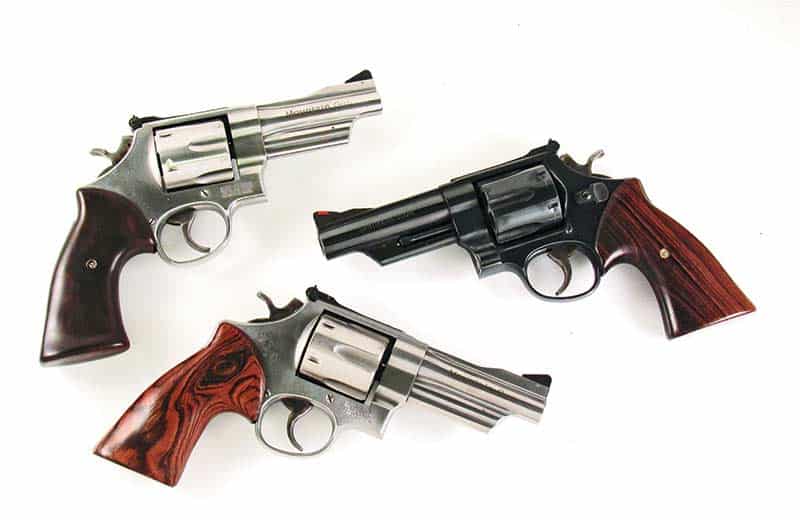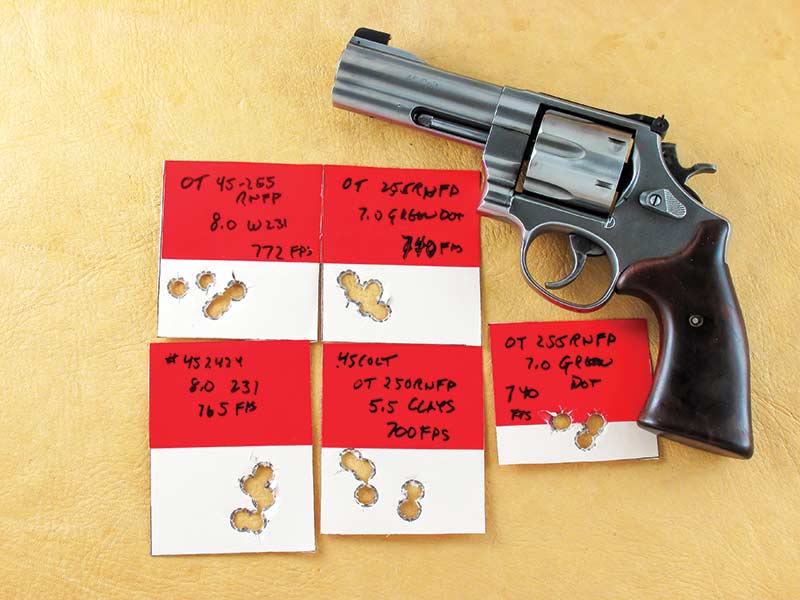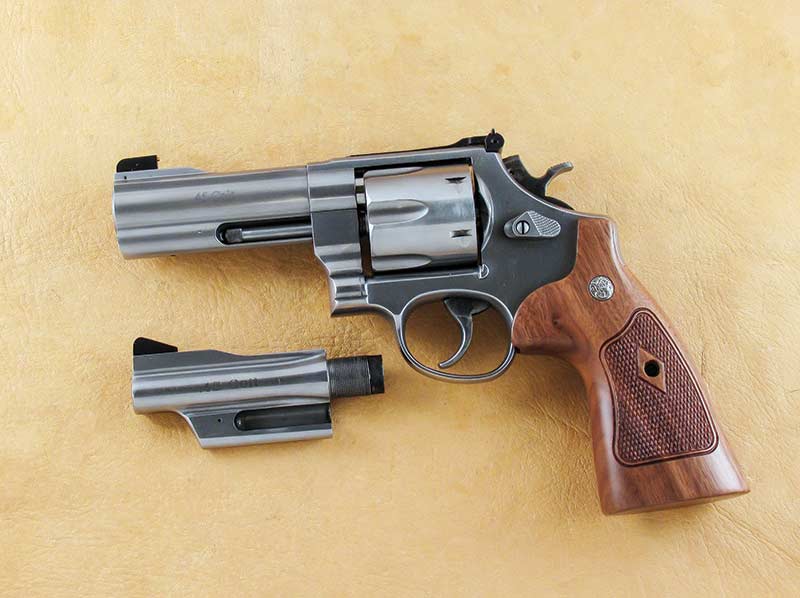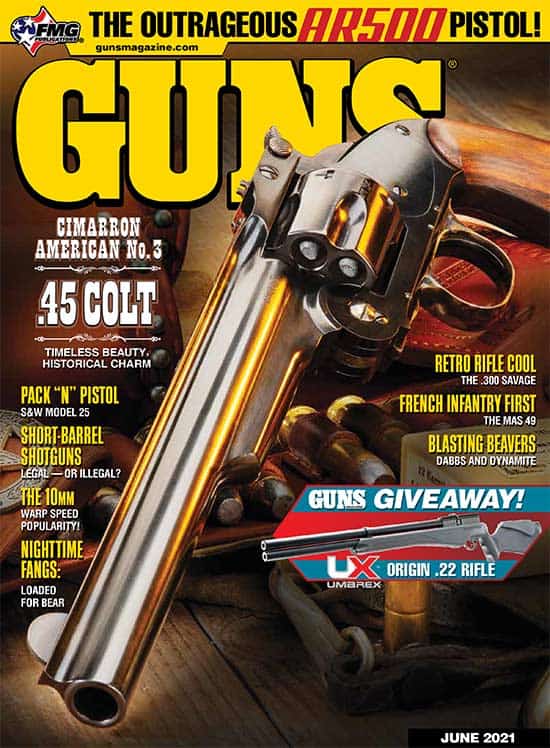Perfect Packin’ Pistol Part 3
The origin of the .45 Colt goes back to the early 1870s. When the military called for tests to select a new sidearm, Colt produced the 1871-72 Open Top. This revolver looks much like the original 1860 and as the name suggests did not have a top strap. As cartridges go, both the Smith & Wesson .44 American and the .44 Colt as tested were not very powerful offerings, using bullets of approximately 210 grains at a muzzle velocity of 700-750 fps.
The military panel was not satisfied and requested Colt come up with not only a new revolver, but a larger, more powerful cartridge as well. By 1873 William Mason of Colt designed the Single Action Army .45 Colt. By the standards of the day — even to this day — the .45 Colt was and is a powerful cartridge. The original loading was a bullet of approximately 255 grains with a muzzle velocity of somewhere around 850-900 fps.
Smith & Wesson sixguns chambered in .45 Colt will be found to be very rare until well after WWII. If the chambering is rare, those with 4″ barrels are virtually nonexistent. The original Triple Lock, produced from 1908 to 1950, was mostly found in .44 Special. However, there are 23 examples known to be chambered in .45 Colt with 6-1/2″ barrels.
With the arrival of the 2nd Model Hand Ejector in 1915, the .45 Colt was more prevalent with 727 manufactured with the standard 6-1/2″ barrel length and only one, which was shipped in 1916, was chambered in .45 Colt with adjustable sights and a 3-3/4″ barrel. I do not know of any 3rd Model/1926 Model Smith & Wessons being chambered in .45 Colt. This would change with the new series of short-action sixguns beginning in 1950.
Smith & Wesson
In 1950 Smith & Wesson introduced the 1950 Target chambered in .44 Special and .45 ACP/.45 Auto Rim. S&W Historian Roy Jinks reports the beginning of a limited production in .45 Colt in 1953. In 1955 the .45 ACP/.45 Auto Rim 1950 Target was improved with a heavier barrel, target stocks and a target hammer. The target trigger and the rifling was also changed to better handle cast bullets. The 1950 Target was very rare in .45 Colt though Elmer Keith had one with a 4″ barrel. When his guns were auctioned off in 2015, this particular one sold for almost $15,000.
The 1955 Target saw a few .45 Colt versions until 1977, the 125th Anniversary of Smith & Wesson. Strangely enough, the Commemorative Revolver now known as the Model 25 was produced in .45 Colt. Smith & Wesson did everything right on this revolver — almost.
The cylinder was too short to handle many available .45 Colt cartridges. This was changed with the Model 25-5, which was not only available in 6-1/2″ and 8-3/8″ barrel lengths but the 4″ .45 Colt became a standard offering for the first time. They are beautiful sixguns with what was known as Smith & Wesson’s “Bright Blue” finish, the same as on their .44 Magnum. Unfortunately, many of these will be found with oversized chamber mouths requiring bullet diameters of at least 0.454″ to produce any accuracy. Proper handloading allows these .45 sixguns to perform well.
Over The Mountain
In 1988/1989 Smith & Wesson began producing stainless steel .45 revolvers. There is a lot of confusion around this production with both .45 ACP and .45 Colt versions offered with each chambering sometimes marked as Model of 1989 or Model of 1988. Examples of both chamberings have been found with each of these two Model markings. At least Smith & Wesson was now on the right track. A whole list of stainless steel .45 Colt Model 625 Smith & Wesson sixguns were produced including a 4″ slim-barreled Mountain Gun and a heavy barreled 4″ under-lugged offering.
I purchased one of the early stainless Mountain Guns in .45 Colt and was quite pleased with it. So much so, when I saw a used one in a gun shop, I decided to make mine a pair. The only problem was the second version would not shoot at all well. I tried measuring the chamber throats and custom tailoring bullets and checking the cylinder/barrel alignment and … nothing worked. Then as we were carefully examining the inside of the barrel, it appeared there was a very slight bulge.
Contacting Smith & Wesson brought the word there were no more slim Mountain Gun barrels available but they did have 4″ heavy underlug barrels. This sixgun went off to the factory to have the new barrel installed and now it performs exceptionally well.
Carrying Through
We have seen Elmer Keith had a 4″ .45 Colt Smith & Wesson but I have no idea how often he used it, if at all, and I do not recall ever reading about it in any of his writings. I do know John Linebaugh, creator of the very powerful .475 and .500 Linebaugh cartridges for his custom five-shot Ruger Bisley Models, carries a .45 Colt as his everyday sixgun. When specifically packing a sixgun for hunting, John goes with one of his custom revolvers but for everyday packing purposes, his number-one choice is a well-worn Smith & Wesson 4″ Model 25-5 chambered in .45 Colt. For most uses, and especially for concealed carry, the 4″ .45 Colt suits him just fine.
Since receiving the recalcitrant .45 Colt sixgun back from Smith & Wesson, I am now fortunate to have examples of all three 4″ barrel configurations. The Mountain Gun with its slim barrel is the easiest to pack, the heavy underlug is the easiest to shoot while the Model 25-5 with its .44 Magnum-style barrel makes a good compromise. It is also exceptionally attractive and eye-pleasing with its deep Bright Blue finish and BearHug Skeeter Skelton-style stocks.
Years ago Dave Scovill set out to improve the Keith bullet, originally Lyman’s 454424 casting out at about 260 grains. For some reason Lyman “improved” this Keith bullet to #452424, which is not only lighter but has a smaller shoulder. Scovill’s design, now the RCBS #45-270SAA, maintains all of Keith’s specifications for a proper .45 bullet. From my alloy it casts out at around 280 grains and loaded over 8.5 grains of Unique, 6.0 grains of Red Dot or 6.0 grains of Clays, results in right at 800 fps from the 4″ barrels of my Smith & Wesson .45 Colt Sixguns — making it an ideal combination for an everyday packin’ load.








